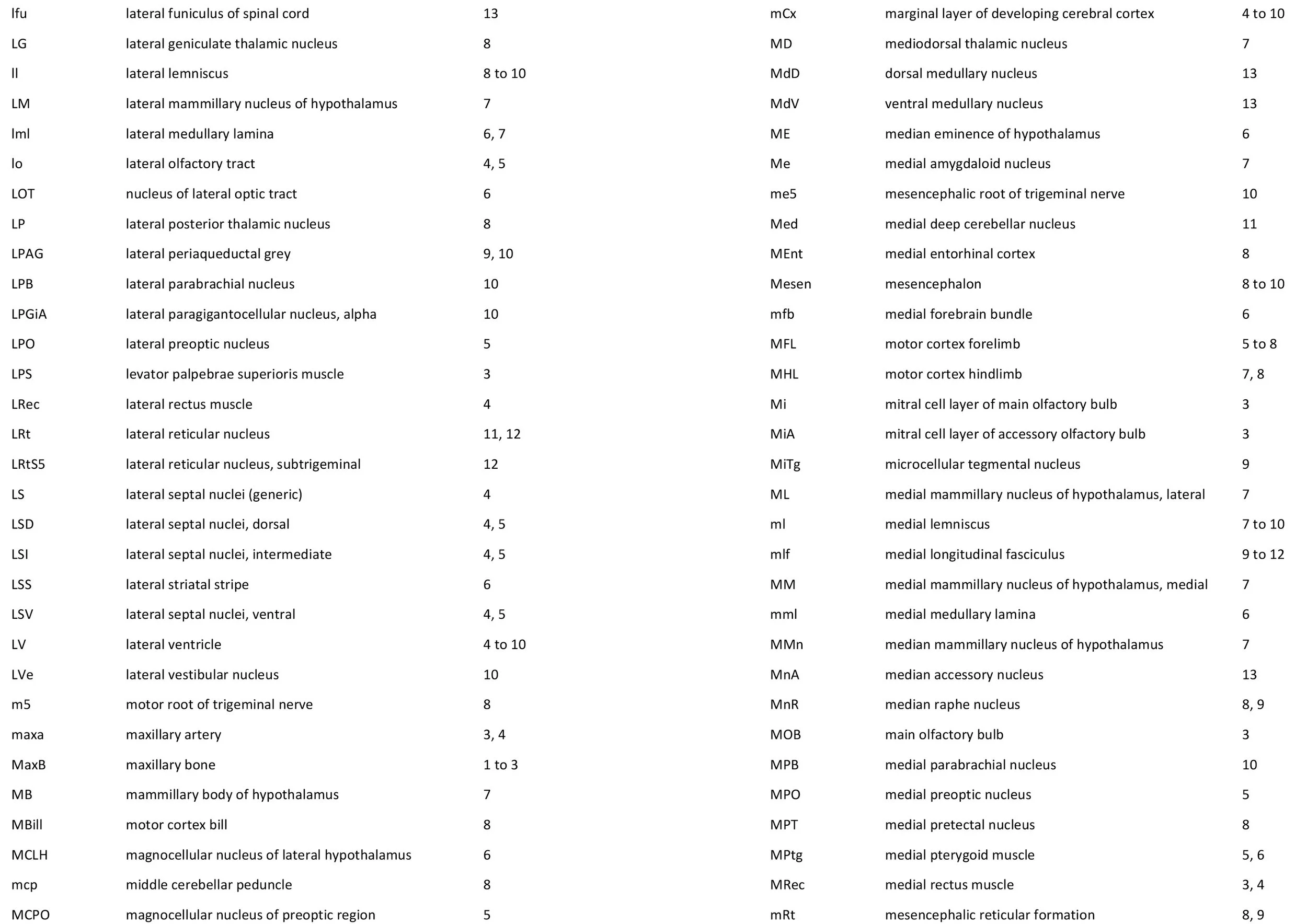Atlas of the Brain of a Juvenile (193 mm body length) Platypus
Introduction
Details on platypus biology can be found at the Platypus page of this website. Please see Platypus Brain for topography of the adult cerebral cortex.
Methods
The specimen illustrated here (AMNH202030) was kindly made available by Prof. Ulrich Zeller of the Museum für Naturkunde, Berlin (see Zeller, 1988, 1989). A body length of 193 mm suggests a post-hatching age of at least 100 days (Ashwell, 2013). The specimen had been embedded in celloidin before being sectioned frontally at a thickness of 35 µm and stained with Azan. The Azan stain is suboptimal for revealing details of brain nuclei and the contrast of grey matter with fibre bundles, but key nuclei are still visible.
General observations
Most of the nuclei of the forebrain, midbrain and medulla are present, but the cerebellum is still immature and poorly foliated. The developmental stage corresponds approximately to a newborn laboratory rat, or a mid-gestation (20 weeks) human fetus.
Olfactory apparatus
Olfactory epithelium is present in the roof of the nasal cavity (olfepith in Plates 1 to 3). The vomeronasal organ (VNO in Plate 1) and vomeronasal nerve (vn in Plates 1 to 3) are also well-developed. The main and accessory olfactory bulbs are of a similar size (see Plate 3), which is indicative of the minor behavioural role played by the main olfactory system in this species. The piriform (primary olfactory) cortex is small, consistent with the minor role of the main olfactory system, but lamination is clearly developed (Pir1 to Pir3 in Plates 4 to 7).
Cerebral isocortex (neopallium)
The cerebral isocortex is at an intermediate stage of development in that there is a substantial cortical plate (CxP in Plates 4 to 10) throughout the extent of the pallium, but the subventricular zone (SubV in Plates 4 to 10) for the generation of cortical and subcortical microneurons is still large and active.
A distinctive feature of the developing platypus cerebral cortex is the sheet of tissue that extends from the pallial/striatal angle around the curvature of the cortex to form a layer between the developing striatum and cortex (SubV/SubPl in Plates 5 to 7). This zone appears to have characteristics of both subventricular and subplate zones as seen in eutherian mammals, in that it contains active mitosis and is also traversed by ascending and descending connections with the cortex (Ashwell and Hardman, 2012a).
The cerebral isocortex shows a clear distinction between the S1 cortex that will serve somato- and electrosensation from the bill and the rest of the cerebral cortex (see S1 upper and lower bill in Plates 5 to 7).
Hippocampus (archipallium)
The hippocampus is sufficiently developed to show cornu Ammonis (CA1 to CA3 in Plates 4 to 9) and dentate gyrus (DG in Plates 5 to 9). Neurons have settled in the cellular layers of both structures (pyramidal and granule cell layers, respectively), but adjacent white matter layers are still indistinct. The fornix (outflow tract of the hippocampus) is present (f in Plates 5, 6).
Subpallial parts of the telencephalon
Putative nuclei of the amygdala, caudate, putamen and septum have been indicated, but these are necessarily notional because nuclear boundaries are indistinct with the Azan stain.
(Dorsal) thalamus
The dorsal thalamus is dominated by an enlarged VPM (ventral posteromedial) thalamic nucleus (Plates 7, 8) for processing somato- and electrosensory information from the bill (upper and lower) and projecting this information to the S1 cortex.
Hypothalamus
Although the Azan stain provides only poor cytoarchitectural contrast, it is possible to discern several major nuclei of the hypothalamus. These include the suprachiasmatic nucleus (SCh in Plate 5), arcuate nuclei (Arc in Plate 6), the ventromedial nucleus of hypothalamus (VMH in Plate 6), and mammillary nuclei of the mammillary body (MB, MM, ML, LM in Plate 7).
Midbrain and isthmus
Lamination of the superior colliculus is almost complete and the main nuclei of the inferior colliculus are present (Plates 9, 10). Other nuclei are difficult to discern.
Cerebellum
The cerebellum is immature, still covered by the external granular (germinal) layer (egl in Plates 10 to 12) that produces the microneurons of the cerebellar cortex. A posterolateral fissure (plf in Plate 12) separates the rostral cerebellum (spino- and pontocerebellum functional components) from the vestibulocerebellum (nodulus and flocculus; see Plates 10 to 12).
Rhombencephalon
The Azan stain allows only an indistinct delineation of medullary nuclei, but the major cranial nerve nuclei can be distinguished (e.g. 12, 10). The most striking feature of the brainstem is the large size of the trigeminal sensory column (Pr5pc, Pr5mc, Sp5O, Sp5I, Sp5C), particularly the most rostral elements close to the trigeminal nerve (5n) entry. See Ashwell et al. (2006) for details of adult trigeminal nuclei in this species and Ashwell and Hardman (2012b) for trigeminal nuclei development.
Acknowledgements
Acknowledgement is given to the American Museum of Natural History who provided this specimen for Prof. Zeller’s work, and which has subsequently been illustrated here. I would like to thank Prof Ulrich Zeller and Dr Peter Giere of the MfN, Berlin Germany, for access to the MfN collection and for all their help during the work.
References
Ashwell KW (2013) Embryology and post-hatching development of the monotremes. In KWS Ashwell (Ed.), Neurobiology of Monotremes: Brain Evolution in Our Distant Mammalian Cousins (1st ed., pp. 31-46). CSIRO.
Ashwell KW, Hardman CD (2012a) Distinct development of the cerebral cortex in platypus and echidna. Brain Behavior and Evolution 79, 57-72.
Ashwell KW, Hardman CD (2012b) Distinct development of the trigeminal sensory nuclei in platypus and echidna. Brain Behavior and Evolution 79, 261–274.
Ashwell KWS, Hardman CD, Paxinos G (2006) Cyto- and chemoarchitecture of the sensory trigeminal nuclei of the echidna, platypus and rat. Journal of Chemical Neuroanatomy 31, 81-107.
Zeller U (1988) The lamina cribrosa of Ornithorhynchus (Monotremata, Mammalia) Anatomy and Embryology178, 513–519.
Zeller U (1989) Die Entwicklung und Morphologie des Schadels von Ornithorhynchus anatinus: (Mammalia, Prototheria, Monotremata). Abhandlungen der Senckenbergischen Naturforschenden Gesellschaft 545, 1–188. Verlag Waldemar Kramer, Frankfurt.


























